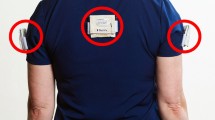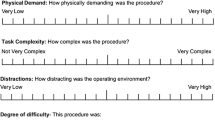Abstract
Background
Working in the operating room is characterized by high demands and overall workload of the surgical team. Surgeons often report that they feel more stressed when operating as a primary surgeon than in the function as an assistant which has been confirmed in recent studies. In this study, intra-individual workload was assessed in both intraoperative functions using a multidimensional approach that combined objective and subjective measures in a realistic work setting.
Methods
Surgeons’ intraoperative psychophysiologic workload was assessed through a mobile health system. 25 surgeons agreed to take part in the 24-hour monitoring by giving their written informed consent. The mobile health system contained a sensor electronic module integrated in a chest belt and measuring physiological parameters such as heart rate (HR), breathing rate (BR), and skin temperature. Subjective workload was assessed pre- and postoperatively using an electronic version of the NASA-TLX on a smartphone. The smartphone served as a communication unit and transferred objective and subjective measures to a communication server where data were stored and analyzed.
Results
Working as a primary surgeon did not result in higher workload. Neither NASA-TLX ratings nor physiological workload indicators were related to intraoperative function. In contrast, length of surgeries had a significant impact on intraoperative physical demands (p < 0.05; η 2 = 0.283), temporal demands (p < 0.05; η 2 = 0.260), effort (p < 0.05; η 2 = 0.287), and NASA-TLX sum score (p < 0.01; η 2 = 0.287).
Conclusions
Intra-individual workload differences do not relate to intraoperative role of surgeons when length of surgery is considered as covariate. An intelligent operating management that considers the length of surgeries by implementing short breaks could contribute to the optimization of intraoperative workload and the preservation of surgeons’ health, respectively. The value of mobile health systems for continuous psychophysiologic workload assessment was shown.




Similar content being viewed by others
References
Schuld J, Bobkowski M, Shayesteh-Kheslat R, Kollmar O, Richter S, Schilling MK (2013) Ärztliche Ressourcennutzung in der Chirurgie auf dem Prüfstand—eine Worksampling-Analyse an einer deutschen Universitätsklinik. Zentralbl Chir 138:151–156
Ryu K, Myung R (2005) Evaluation of mental workload with a combined measure based on physiological indices during a dual task of tracking and mental arithmetic. Int J Ind Ergon 35:991–1009
DiDomenico A, Nussbaum MA (2008) Interactive effects of physical and mental workload on subjective workload assessment. Int J Ind Ergon 38:977–983
Wetzel CM, Kneebone RL, Woloshynowych M, Nestel D, Moorthy K, Kidd J, Darzi A (2006) The effects of stress on surgical performance. Am J Surg 191:5–10
Gaba DM, Howard SK (2002) Fatigue among clinicians and the safety of patients. N Engl J Med 347:1249–1255
Arora S, Hull L, Sevdalis N, Tierney T, Nestel D, Woloshynowych M, Darzi A, Kneebone R (2010) Factors compromising safety in surgery: stressful events in the operating room. Am J Surg 199:60–65
Carswell CM, Clarke D, Seales WB (2005) Assessing mental workload during laparoscopic surgery. Surg Innov 12:80–90
Howard SK, Gaba DM (2004) Trainee fatigue: are new limits on work hours enough? CMAJ 170:975–976
Zheng B, Cassera MA, Martinec DV, Spaun GO, Swanström LL (2010) Measuring mental workload during the performance of advanced laparoscopic tasks. Surg Endosc 24:45–50
Buddeberg-Fischer B, Klaghofer R, Stamm M, Siegrist J, Buddeberg C (2008) Work stress and reduced health in young physicians: prospective evidence from Swiss residents. Int Arch Occup Environ Health 82:31–38
Böhm B, Rötting N, Schwenk W, Grebe S, Mansmann U (2001) A prospective randomized trial on heart rate variability of the surgical team during laparoscopic and conventional sigmoid resection. Arch Surg 136:305–310
Belkic KL, Landsbergis PA, Schnall PL, Baker D (2004) Is job strain a major source of cardiovascular disease risk? Scand J Work Environ Health 30:85–128
Dine E, Fouquet A, Esquirol Y (2012) Cardiovascular diseases and psychosocial factors at work. Arch Cardiovasc Dis 105:33–39
Ellins E, Halcox J, Donald A, Field B, Brydon L, Deanfield J, Steptoe A (2008) Arterial stiffness and inflammatory response to psychophysiological stress. Brain Behav Immun 22:941–948
DiDomenico A, Nussbaum MA (2011) Effects of different physical workload parameters on mental workload and performance. Int J Ind Ergon 41:255–260
Rieger A, Neubert S, Behrendt S, Weippert M, Kreuzfeld S, Stoll R (2012) 24-Hour Ambulatory Monitoring of Complex Physiological Parameters with a Wireless Health System. Feasibility, user compliance and application. Proceedings of the 9th IEEE International Multiconference on Systems, Signals and Devices (SSD), Chemnitz, Germany
Reason J (1995) Understanding adverse events: human factors. Qual Health Care 4:80–89
Berland A, Natvig GK, Gundersen D (2008) Patient safety and job-related stress: a focus group study. Intensive Crit Care Nurs 24:90–97
Johnstone PL (1999) Occupational stress in the operating theatre suite: should employers be concerned? Aust Health Rev 22:60–80
Kuhn EW, Choi YH, Schonherr M, Liakopoulos OJ, Rahmanian PB, Choi CY, Wittwer T, Wahlers T (2013) Intraoperative stress in cardiac surgery: attendings versus residents. J Surg Res 182:e43–e49
Kurmann A, Tschan F, Semmer NK, Seelandt J, Candinas D, Beldi G (2012) Human factors in the operating room—the surgeon’s view. Trends Anaesth Crit Care 2:224–227
Lingard L, Garwood S, Poenaru D (2004) Tensions influencing operating room team function: does institutional context make a difference? Med Educ 38:691–699
Becker WGE, Ellis H, Goldsmith R, Kaye AM (1983) Heart rates of surgeons in theatre. Ergonomics 26:803–807
Neubert S, Arndt D, Thurow K, Stoll R (2010) Mobile real-time data acquisition system for application in preventive medicine. Telemed J E Health 16:504–509
Neubert S, Behrendt S, Rieger A, Weippert M, Kumar M, Stoll R (2011) Echtzeit-Telemonitoring-System in der Präventivmedizin. In: Duesburg F (ed) E-Health 2012 – Informationstechnologien und Telematik im Gesundheitswesen. Medical Future Verlag, Solingen, pp 249–252
Hart SG, Staveland LE (1988) Development of NASA-TLX (Task Load Index): results of empirical and theoretical research. Adv Psychol 52:139–183
Hart SG (2006) NASA-task load index (NASA-TLX); 20 years later. Proceedings of the Human Factors and Ergonomics Society, HFES 2006, San Francisco, CA, pp 904–908
Szalma JL, Warm JS, Matthews G, Dember WN, Weiler EM, Meier A, Eggemeier FT (2004) Effects of sensory modality and task duration on performance, workload, and stress in sustained attention. Hum Factors 46:219–233
O’Donnell RD, Eggemeier FT (1986) Workload assessment methodology. In: Boff K, Kaufman L, Thomas J (eds) Handbook of perception and human performance, vol II., Cognitive Processes and PerformanceWiley Interscience, New York, pp 42.41–42.49
Arora S, Sevdalis N, Nestel D, Woloshynowych M, Darzi A, Kneebone R (2010) The impact of stress on surgical performance: a systematic review of the literature. Surgery 147:318–330
Lockley SW, Cronin JW, Evans EE, Cade BE, Lee CJ, Landrigan CP, Rothschild JM, Katz JT, Lilly CM, Stone PH, Aeschbach D, Czeisler CA (2004) Effect of reducing interns’ weekly work hours on sleep and attentional failures. N Engl J Med 351:1829–1837
Samkoff JS, Jacques CH (1991) A review of studies concerning effects of sleep deprivation and fatigue on residents’ performance. Acad Med 66:687–693
Von dem Knesebeck O, Klein J, Grosse Frie K, Blum K, Siegrist J (2010) Psychosoziale Arbeitsbelastungen bei chirurgisch tätigen Krankenhausärzten. Dtsch Ärztebl 104:248–253
Buddeberg-Fischer B, Klaghofer R, Buddeberg C (2005) Arbeitsstress und gesundheitliches Wohlbefinden junger Ärztinnen und Ärzte. Z psychosom Med Psychother 51:163–178
Klein MI, Warm JS, Riley MA, Matthews G, Gaitonde K, Donovan JF (2008) Perceptual distortions produce multidimensional stress profiles in novice users of an endoscopic surgery simulator. Hum Factors 50:291–300
Czyzewska E, Kiczka K, Czarnecki A, Pokinko P (1983) The surgeon’s mental load during decision making at various stages of operations. Eur J Appl Physiol Occup Physiol 51:441–446
Song MH, Tokuda Y, Nakayama T, Sato M, Hattori K (2009) Intraoperative heart rate variability of a cardiac surgeon himself in coronary artery bypass grafting surgery. Interactive Cardiovasc Thorac Surg 8:639–641
Klein M, Andersen LPH, Alamili M, Gögenur I, Rosenberg J (2010) Psychological and physical stress in surgeons operating in a standard or modern operating room. Surg Laparosc Endosc Percutan Tech 20:237–242
Malhotra N, Poolton JM, Wilson MR, Ngo K, Masters RSW (2012) Conscious monitoring and control (reinvestment) in surgical performance under pressure. Surg Endosc. doi:10.1007/s00464-012-2193-8
Zheng B, Jiang X, Tien G, Meneghetti A, Panton ONM, Atkins MS (2012) Workload assessment of surgeons: Correlation between NASA TLX and blinks. Surg Endosc 26:2746–2750
Fahrenberg J, Myrtek M (1996) Ambulatory assessment: computer-assisted psychological and psychophysiological methods in monitoring and field studies. Hogrefe & Huber, Seattle
Haga S, Shinoda H, Kokubun M (2002) Effects of task difficulty and time-on-task on mental workload. Jpn Psychol Res 44:134–143
Swangnetr M, Kaber D, Vorberg E, Fleischer H, Thurow K (2014) Identifying automation opportunities in life science processes through operator task modeling and workload assessment. In: Ahram T, Karwowski W, Marek T (eds) 5th International Conference on Applied Human Factors and Ergonomics AHFE 2014, Krakow, Poland, pp 6248–6255
Engelmann C, Schneider M, Kirschbaum C, Grote G, Dingemann J, Schoof S, Ure BM (2011) Effects of intraoperative breaks on mental and somatic operator fatigue: a randomized clinical trial. Surg Endosc 25:1245–1250
Engelmann C, Schneider M, Grote G, Kirschbaum C, Dingemann J, Osthaus A, Ure B (2012) Work breaks during minimally invasive surgery in children: patient benefits and surgeon’s perceptions. Eur J Pediatr Surg 22:439–444
Fahrenberg J, Myrtek M (2001) Progress in ambulatory assessment : computer-assisted psychological and psychophysiological methods in monitoring and field studies. Hogrefe & Huber, Seattle
Fahrenberg J, Myrtek M, Pawlik K, Perrez M (2007) Ambulatory assessment—capturing behavior in daily life. A behavioral science approach to psychology. Psychol Rundsch 58:12–23
Myrtek M (2004) Heart and emotion: ambulatory monitoring studies in everyday life. Hogrefe & Huber, Cambridge, MA
Rau R, Richter P (1996) Psychophysiological analysis of strain in real life work situations. In: Fahrenberg J, Myrtek M (eds) Ambulatory assessment: computer-assisted psychological and psychophysiological methods in monitoring and field studies. Hogrefe & Huber, Kirkland, USA, pp 271–285
Wilson MR, Poolton JM, Malhotra N, Ngo K, Bright E, Masters RS (2011) Development and validation of a surgical workload measure: the surgery task load index (SURG-TLX). World J Surg 35:1961–1969
Acknowledgments
The authors are very grateful to the reviewers for their valuable comments and suggestions. This study was realized as part of the project eHealth MV, funded by the State of Mecklenburg-Western Pomerania in Germany as well as by the Federal Ministry of Education and Research (BMBF) in the program “Center for Innovation Competence (ZIK)”.
Disclosures
Drs. Rieger, Fenger, Neubert, Weippert, Kreuzfeld, and Prof. Stoll have no conflicts of interest or financial ties to disclose.
Author information
Authors and Affiliations
Corresponding author
Additional information
Annika Rieger and Sebastian Fenger are co-first authors.
Rights and permissions
About this article
Cite this article
Rieger, A., Fenger, S., Neubert, S. et al. Psychophysical workload in the operating room: primary surgeon versus assistant. Surg Endosc 29, 1990–1998 (2015). https://doi.org/10.1007/s00464-014-3899-6
Received:
Accepted:
Published:
Issue Date:
DOI: https://doi.org/10.1007/s00464-014-3899-6




